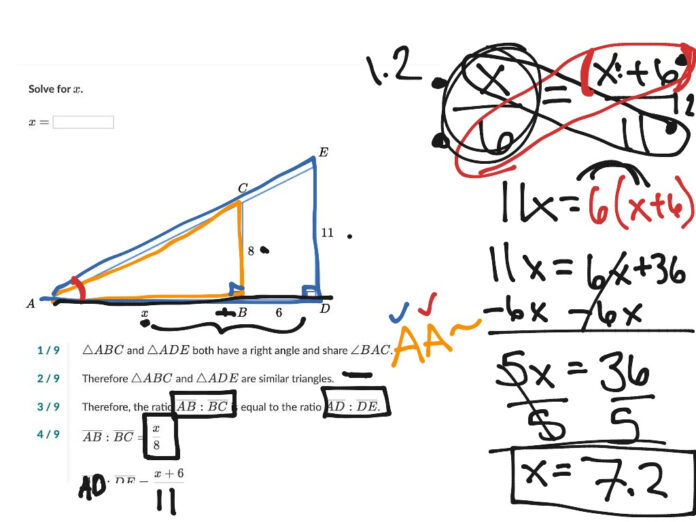Understanding the intriguing world of geometry, specifically similar triangles, offers not only intellectual stimulation but also a sense of accomplishment and empowerment. The idea that triangles can be proportionally related provides a gateway to solving complex problems through relatively straightforward methods. This exploration delves into the concept of similar triangles, the nuances of solving for x, and the broader implications for mathematical understanding and mood enhancement.
Similar triangles are defined as triangles that have the same shape but not necessarily the same size. This similarity is established through the equality of their corresponding angles and the proportionality of their corresponding sides. When two triangles are similar, the ratios of the lengths of their corresponding sides are constant, offering fertile ground for algebraic manipulation and problem-solving. In this analysis, we navigate the methodology of solving for the unknown variable x within similar triangles, uncovering both procedural authenticity and intellectual satisfaction.
When faced with a problem involving similar triangles, one typically recognizes key features that lend themselves to the application of proportionality. The first task in unraveling these geometric puzzles is to identify the pairs of similar triangles and their corresponding sides and angles. With acute awareness of these relationships, a mathematician can set up a proportion that equates the ratios of side lengths. For instance, if triangle ABC is similar to triangle DEF, then:
[ frac{AB}{DE} = frac{BC}{EF} = frac{AC}{DF} ]
This relationship serves as the foundation for finding the elusive x. Once established, the next step involves substituting known values into the equation to facilitate further calculations.
This leads us to an essential inquiry: how does one navigate the labyrinth of unknowns to pinpoint x? The answer lies in leveraging the basic principle of cross-multiplication, a technique both efficient and empowering. By executing cross-multiplication, one transforms the proportion into a more manageable equation, prepped for a solution. Consider an example where side lengths provide some knowns and an unknown x to solve for. The equation manifests as:
[ a cdot EF = b cdot x ]
By isolating x, one achieves clear enlightenment and an engaging sense of fulfillment as archaic geometrical constructs morph into tangible numerical manifestations. The solution rings true:
[ x = frac{a cdot EF}{b} ]
This systematic approach not only allows for effective problem-solving but also fortifies the mathematical foundation for learners, promoting confidence and joy.
Moreover, the appreciation for similar triangles extends beyond mere calculations; it embodies a philosophical stance relevant to broader life perspectives. The parallelism epitomized by similar triangles invites introspection about relationships and growth. Just as triangles reflect proportionality through their dimensions, individuals can mirror this idea in their personal or professional endeavors. The realization that smaller steps—aided by calculated decisions—can lead to proportional larger outcomes is indeed a mood booster.
With the mechanics of solving for x in similar triangles unveiled, let us consider the broader implications associated with mathematical reasoning. Engaging with geometry presents the unique chance to cultivate critical thinking skills and problem-solving strategies that ripple into other areas of life. The act of grappling with numerical challenges fosters resilience, prompting individuals to embrace complexity rather than shy away from it. Such experiences not only enhance academic performance but also bolster self-esteem and personal satisfaction.
As learners become adept at identifying and resolving for x via similar triangles, their skills can translate into real-world applications. From architectural design to engineering and even in fields such as art, recognition of proportional relationships manifests itself in diverse ways. Each successful resolution of a problem nurtures not only an intellectual acumen but also a profound sense of achievement, acting as a mood-enhancing factor in the learner’s journey.
For those who face obstinate challenges in mathematics or find themselves wrestling with abstract concepts, understanding similar triangles provides a pragmatic outlet. The perpetual relationship of angles and sides mirrors the universal principle of balance—an idea that resonates on a deeply personal level. With practice, the layers of complexity surrounding mathematics dissolve into simple yet profound realizations, empowering the individual.
In summation, the exploration of similar triangles, particularly the quest to solve for x, encapsulates a journey through intellectual striving, emotional growth, and personal empowerment. The methodologies engaged in unraveling these geometric enigmas cultivate a deep appreciation for mathematics, illustrating that the abstract can yield tangible, rewarding experiences. By embracing the challenge of similar triangles, students of all ages can experience the joyous interconnectedness of mathematics, life, and personal development.
Ultimately, as one navigates through the captivating intersections of angles and sides, the experience transcends the confines of mathematics, perhaps inspiring a liberated and enriched outlook. The next time you encounter similar triangles, remember the emotional resonance that can be derived from mathematical reasoning—a narrative of growth, discovery, and unwavering potential.





























